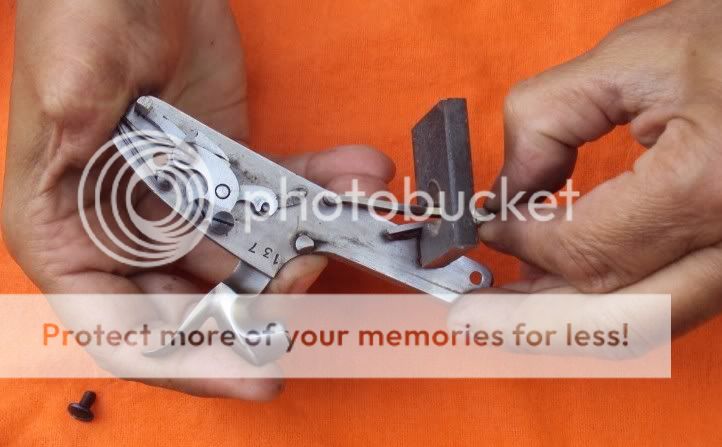Daryl gave me this instruction for dismantling lock plates of my Kodiak rifle in order to blued them.
As I thought it was very good and it helps me much, I want to share it with some pictures I took while I was following it.
Lock dismantling.Remove the screw that holds the hammers on the tumbler.

Remove all the lock's innards- but FIRST - you should have a mainspring vice to do this, but vice grips can be used, if done carefully. Also, an 1/8" to 3/16" thick piece of steel with a 1/4" slot in it will also work as a mainspring vise.

Slide the 'tool' I described up the mainspring with the locks at full cock - or lightly grip the main spring with the vice grips - lock ar full cock position. Now, gently trip the sear and move the hammer forward to make the spring's engagement on the tumbler swivel loose. Remove the mainspring and set down without tripping the vice-grips.
Loosen the sear spring until you can release it from it's 'catch' in the lock plate, relieving it's pressure against the sear. Now, remove the sear and screw spring. Remove the screws holding the tumbler plate on, then remove the plate.

In order to remove the hammer from the tumbler and free it from the lock plate, you will need a round 'drift' of brass, and a hammer. Hold the lock plate in your palm, tumbler down, hammer facing up. Put a brass drift down into the screw hold of the hammer. It should be brass and just clear the threads but go to the bottom of the hole. Tap the drift with a small hammer and the tumbler should drop off the hammer into your hand, which also loosens the plate. You can now blue the hammer and plate.

NOTE - if you try to pry the hammer off the tumbler, you may break the tumbler projection. Then, the lock will need a new tumbler - don't do this. You need to tap it off as indicated, unless it is loose. These are not high grade guns and it is possible the square hole in the hammer is oversize. If the hammer isn't loose, you must do as I wrote.
Hope this helps. The more times you assemble and remove the lock parts, the easier a job it becomes.
-------------------
Daryl
Hope this helps.
Martin

